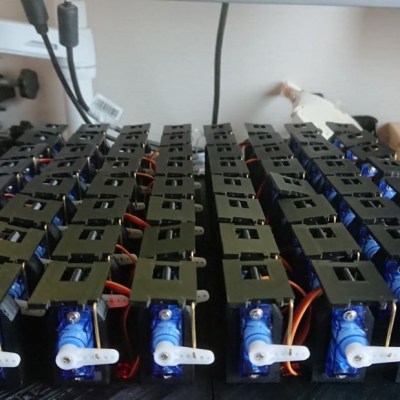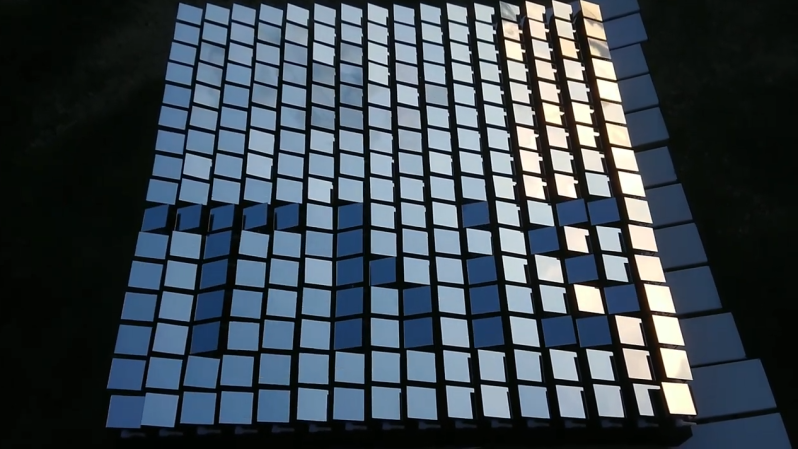Mechanical displays use a variety of different methods to represent data with physical objects, and [AIRPOCKET]’s Mechanical Display aims to be a platform anyone can use. Each “pixel” in this display is a panel of some kind, and different effects can be had by moving individual panels to different angles. Not only can images be represented, but the patterns of the movements themselves can be beautiful as well.

These sorts of displays are fertile ground for artistic expression (one memorable implementation of this basic idea was the wooden mirror, which used varnished tiles of wood) but anyone looking to use the concept has usually been on their own when it comes to implementation.
The idea [AIRPOCKET] has is to make this kind of installation easier to implement. This method uses economical mini RC servos and 3D-printed pieces to create modular segments that can be assembled into whatever configuration one may need.
The material of the panels matters, too. Just below the page break, you can see a large unit with each “pixel” consisting of a mirrored square that reflects daylight. There’s also a video of an earlier prototype that uses some ridged two-color pieces to create a simple 4×4 three-level greyscale display.
There are a lot of possibilities if [AIRPOCKET] can make this sort of display more easily accessible, and that makes it a contender in the 2023 Hackaday Prize.



















Interesting.
Maybe the camera angle in the top video isn’t doing it justice. I have a hard time reading the message until I squint or, even more effectively, take off my glasses.
How well does it reflect light to another surface, I wonder. It’s effectively a giant scale, low pixel count DLP mirror array.
The grayscale one is neat.
This project reminds me when my daughter was in kid soccer, I wanted to build some sort of portable scoreboard to take to her games.
The noise it makes during the demo kind of reminds me of drum 🥁 squad.
He made a 16×16 DLP!
If the cycle time were faster, it would double as a mechanical cicada.
What a coincidence! I actually create a device called the “Master of Cicada Catching” as well.
https://hackaday.io/project/190651-portable-sound-visualization-ar-device
I’m enjoying how tactile this display is…
Which leads to the thought of using this as an input device.
It might be the rare “touch” screen I’d agree with.
The writeup doesn’t mention Daniel Rozin’s mechanical mirrors. Did the constructor come up with the idea independently? I’m being charitable as it looks like he took Rozin’s idea unacknowledged. Granted he’s not using a camera to drive the pixels.
Thank you very much for your valuable feedback. I am airpocket, the one who designed this display. Unfortunately, I just found out about the amazing work of Daniel Rozin. I am currently a bit confused about how to handle the situation.
Firstly, I am considering explicitly acknowledging the existence of this great predecessor in the article. Additionally, I had initially planned to open-source the design of this device, but now I feel unsure if that would be appropriate. Alternatively, based on the context of this blog, would it be acceptable to proceed with open-sourcing the device?
To provide some background, I am not from an English-speaking background, nor am I an artist, which is why I was not aware of his work. I also feel that the starting point and ideas behind my design are different from his, but I understand that the solution I arrived at (in terms of the device itself rather than the artistic expression) is very similar to his work.
Regarding the mention of using a camera, it is true that in the grayscale version I have partially shared, some implementations do use a camera.
I would greatly appreciate receiving advice from many people regarding how to handle this display moving forward, as I am currently struggling to make a sound judgment on the matter.
Waggling a mirror is hardly rocket science. Your conscience should be clear.
Thank you for your comment, Alphatek. As my conscience reminds me not to forget respect for great predecessors, I would like to mention Daniel Rozin’s works.
I sent an email explaining the situation to Daniel Rozin, and fortunately, I received a reply. I have provided an explanation at the beginning of the artwork page, so if you are interested, please refer to it.
I’m sorry, but I have to speak out against this one. In art, you can’t really “take” an idea. That would imply you are able to remove an idea from someone’s possession. All art, science, technology, and math is built on the ideas of people who have come before you.
You can’t build any electronics because you didn’t personally credit the 100000 people who helped develop the technologies you took advantage of.
You can’t paint anything on canvas, because you didn’t credit the millions who used that medium first.
From the perspective of patent law or copyright, searching for prior art does have merit to avoid legal trouble. But neither apply here. Artists have been coming up with similar ideas to eachother and implementing them indepenently since art was even a thing.
I’ve been looking into building a similar mirror display. Granted I haven’t gotten around to it yet, but I conceived of the idea from learning how a DLP worked. When I build it I’ll be sure to not mention every single artist who has done something similar, and only list inspiration that actually applies (the DLP MEMS device).
For just a milli-sec due to the sounds aswell. I though the first vid was someone controlling windows in a building.
Version 3 maybe. :)